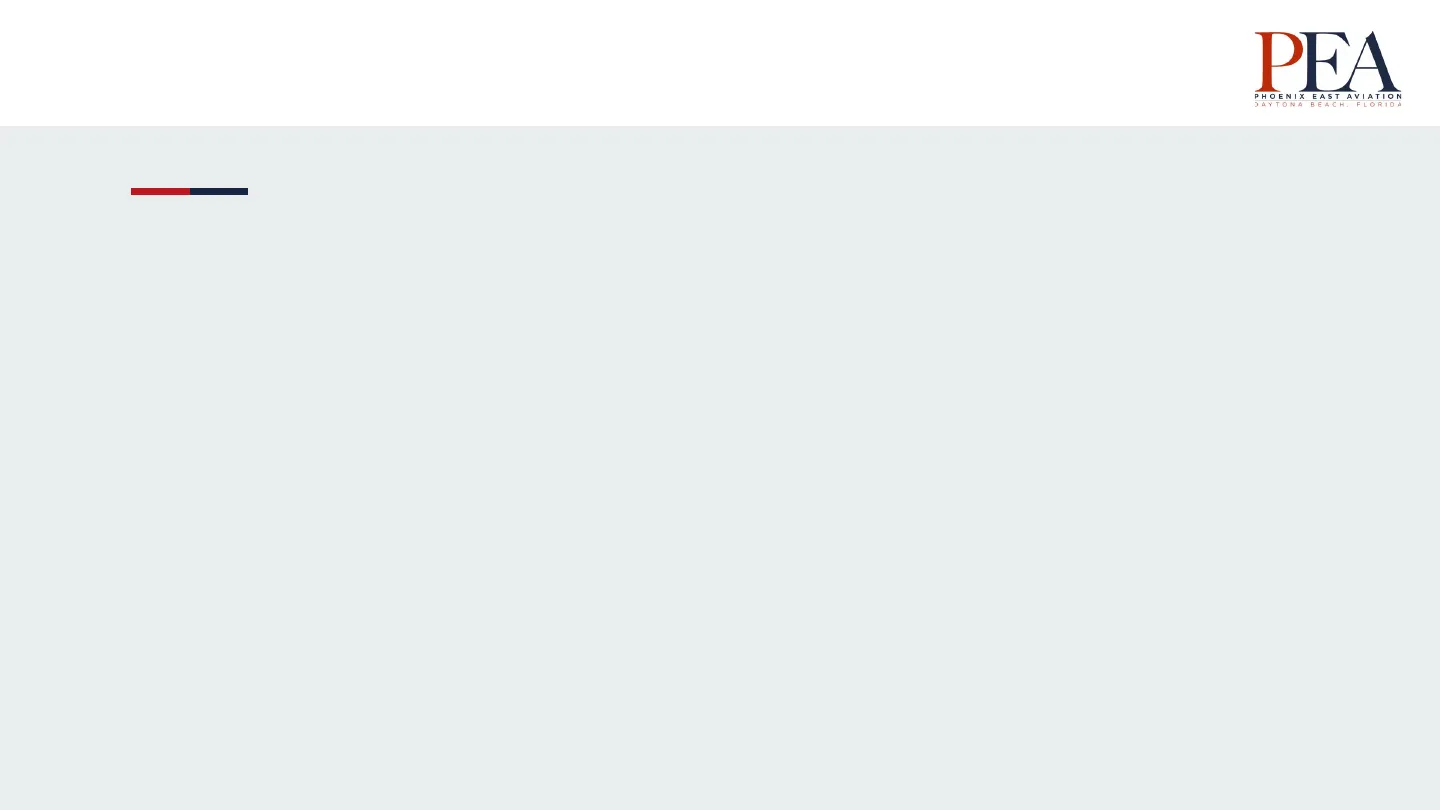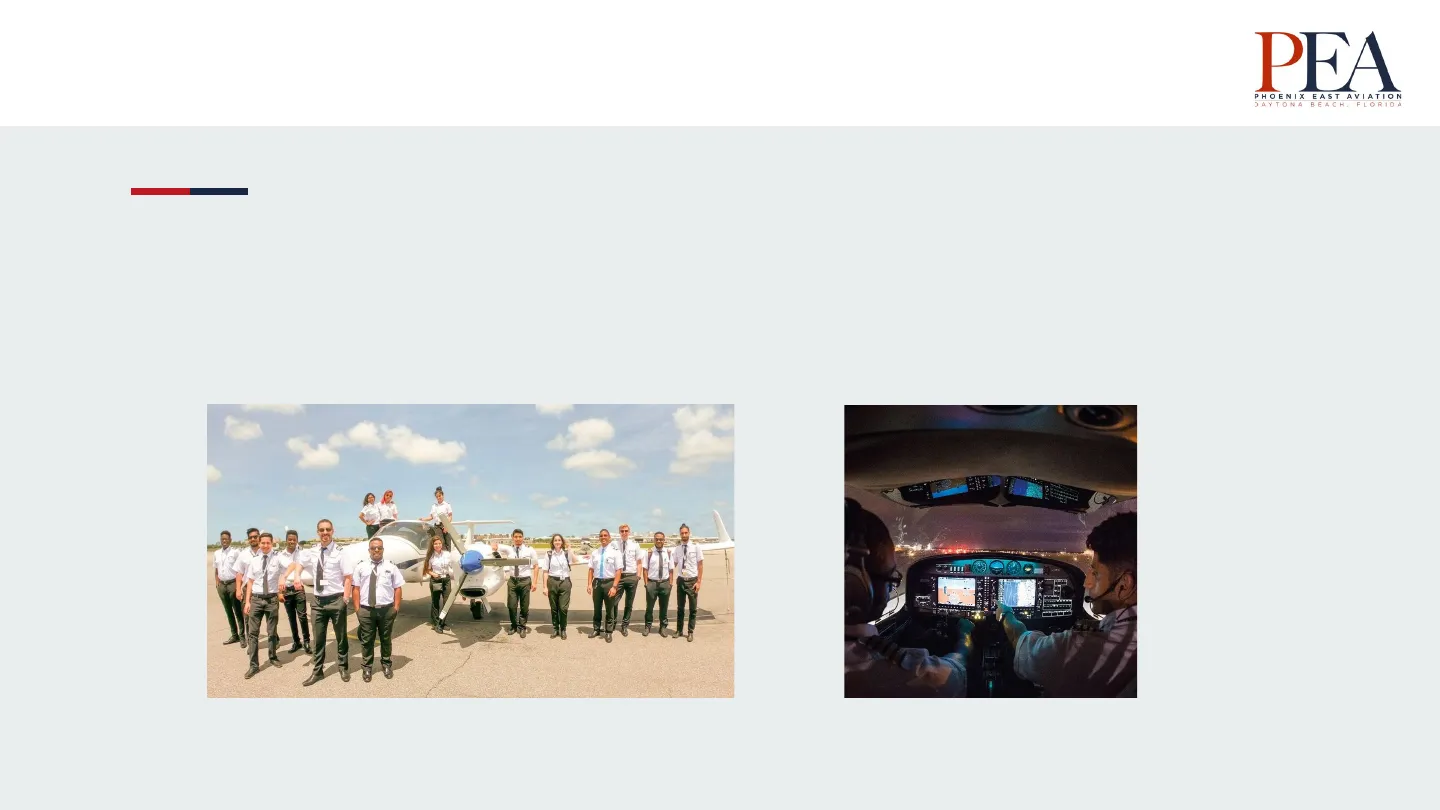Instrument Rating Ground School: Human Factors in Aviation by Phoenix East Aviation
Slides from Phoenix East Aviation about Instrument Rating Ground School. The Pdf provides crucial information for pilot training, covering human factors in aviation such as stress, fatigue, and the impact of alcohol and drugs on performance. This material is designed for professional training in the aeronautical sector.
See more67 Pages


Unlock the full PDF for free
Sign up to get full access to the document and start transforming it with AI.
Preview
Phoenix East Aviation Instrument Rating Ground School
Daytona Beach, Florida
PEA PHOENIX EAST AVIATION DAYTONA BEACH, FLORIDA Instrument Rating Ground School Day 1: L1 GL1- Human FactorsPEA PHOENIX EAST AVIATION DAYTONA BEACH, FLORIDA Welcome to PEA!
Course Overview
Course Elements and Materials
- Course Elements:
○ The 141 IR Course consists of three stages of training as shown in the timeline.
- Course Materials:
AA-H-8003-150 Instrument Flying Handbook 2021 FAR/AIM Federal Aviation Regulatkını U.S. Department FEDERAL MANO U.S. Department of Tramporichon Federal Axicrian Administration Instrument Procedures Handbook JEPPESEN. GUIDED FLIGHT DISCOVERY INSTRUMENT COMMERCIAL FEBET 1.9 NM 0 1900 Jeppesen Instrument Commercial Handbook Federal Aviation Regulations / Aeronautical Information Manual Instrument Flying Handbook FAA-H-8083HIEB Instrument Procedures Handbook
Training Stages
Stage 1: Basic Instrument Flying Student learns basic instrument flying. Navigating using radio navigation and transition from VFR flying to flying under the hood.
Stage 2: Instrument Procedures Student now learns the skills of flying the different segments of an IFR flight like Departure Procedures, Holds, Instrument Approach Procedures etc.
Stage3: IFR Cross Country This stage consists of putting together all of the instrument knowledge gained so far and learning to plan and fly IFR cross countries. The student also gets accustomed with the different challenges that come along IFR flying.
Final Training and Practical Test Commonly referred to as the End Of Course, this is the final test phase of the training. Successful completion of this course requires satisfactory performance in the End Of Course Oral and Flight Checks.
Exams and Tests
- The classes will be completed over a period of 6 weeks. These weeks include 4 weeks of IR training, 1 week of FAA written test prep and 1 week of C/SRM classes.
- The IR portion of the groundschool has 3 stages and 4 tests, one for each stage and one for the end of course.
- The exams will be completed on MOODLE.
- Each student must score at least 80 % in each of these 4 moodle exams to satisfactorily complete the groundschool.
- GC DOUC
Policies and Procedures
- Attendance Policy: Every student must be present for each session. In case a student is unable to attend a session, the student would be required to cover the day's topic with their instructor in a mandatory 2 hour ground session.
- More than 3 absences might result in student having to repeat the entire ground school course.
- Uniforms policy must be strictly adhered to. There will be NO EXCUSE for any deviation from the school's uniform policy.
- GC DOUC
Instrument/Commercial Training and Opportunities
Adding an IR to your existing private pilot certificate allows you to fly a wider range of weather conditions than you can as a VFR pilot.§61.113
Private Pilot Privileges
- Act as Pilot in Command (PIC) and carry passengers as long as the PIC pays at least the pro rata share of the operating expenses with the passengers provided the expenses involve only fuel, oil, airport expenditures, or rental fees.
- Act as PIC, for compensation or hire in connection with any business or employment as long as:
○ The flight is only incidental to that business or employment ○ The aircraft does not carry passengers or property for compensation or hire
- Act as PIC of a charitable, nonprofit, or community event flight
- May be reimbursed for aircraft operating expenses that are directly related to search and location operations, provided the expenses involve only fuel, oil, airport expenditures, or rental fees
- A private pilot who is an aircraft salesman and who has at least 200 hours of logged flight time may demonstrate an aircraft in flight to a prospective buyer.
- Tow a glider or an unpowered ultralight vehicle as long as requirements are met§61.113
Private Pilot Limitations
- Cannot act as pilot in command of an aircraft that is carrying passengers or property for compensation or hire
- Cannot act as pilot in command of an aircraft for compensation or hire
- May not pay less than the pro rata share of the operating expenses of a flight with passengers, provided the expenses involve only fuel, oil, airport expenditures, or rental fees.
Definitions
VFR stands for visual flight rules, and the term refers to a set of rules created by the FAA for flight in VMC, or visual meteorological conditions. These are terms that even pilots sometimes use incorrectly. To avoid confusion, it's best to learn the correct terminology from the start: When referring to VFR or VMC, VFR is the type of flight operation or type of flight plan flown by the pilot, and VMC refers to the type of weather conditions which are defined by visibility and cloud clearance requirements ..
IFR stands for instrument flight rules - the set of rules that govern aircraft that fly in IMC, or instrument meteorological conditions. In general terms, instrument flying means flying in the clouds. More specifically, IMC is defined as weather that is "below the minimums prescribed for flight under Visual Flight Rules."
Instrument Training Requirements
- Hold at least a current private pilot certificate, or be concurrently applying for a private pilot certificate, with an airplane, helicopter, or powered-lift rating appropriate to the instrument rating sought;
- Be able to read, speak, write, and understand the English language.
- Complete specific training and flight time requirements described in FARs.
- Pass a knowledge test.
- Successfully complete the practical test.
LfH+ PUSSY JOHN 712ME ITE 26:42 118.575++ 128375 15 128.375 121300 22 74% Power GPS AP YD ALT T 24000m 02 111.70- 115.40 ARTCC DENVER HAY :24000 100 % Por 74 24200 150- -1 24107 24000 13 - 120 WOHIN CATEGORY ARPLANE 23800 INCLUDING SPINS APPROVED Y HOG 214" 218 STO BAR UNEARLY WITH ALTITUDE 175 KIAN HA BUL V 28.0 5.001 175 N216BD RT 15505 car -37℃ DAT -357 SPOR 3350 ALT * UTC 183424 3.40 2480 110 ABOVE 17:300 Vir AND VND REDUCE
Instrument Training: Flying on the Ground
Part of your instrument training may be accomplished in a flight simulator, flight training device or aviation training device. The FARs specify the maximum hours that can be used in either a flight simulator or FTD or an ATD.
LfH+ PUSSY JOHN 712ME ITE 26:42 118.575++ 128375 15 128.375 121300 22 74% Power GPS AP YD ALT T 24000m 02 111.70- 115.40 ARTCC DENVER HAY :24000 100 % Por 74 24200 150- 24107 13 - 120 NORMAL CATEGORY AMPLANE 23800 110 ABOVE 17:300 Ver AND VND REDUCE UNEARLY WITH ALTITUDE 175 KIAN HA BUL V 28.0 N216BD RT 15505 car -37℃ DAT -357 SPOR 3350 ALT * UTC 183424 3.40 2480 24000 GORE ANIPLANE Y HOG 214"
Instrument Training Equipment
Part of your instrument training may be accomplished in a flight simulator, flight training device or aviation training device. The FARs specify the maximum hours that can be used in either a flight simulator or FTD or an ATD. Equipment like a simulator can be very useful in instrument training to develop instrument skills.
LfH+ PUSSY JOHN 712ME ITE 26:42 118.575++ 128375 15 128.375 121300 22 74% Power GPS AP YD ALT T 24000m 02 111.70- 115.40 ARTCC DENVER HAY :24000 100 % Por 74 24200 150- 2480 24107 24000 13 - GORE ANIPLANE 23800 110 ABOVE 17:300 Ver AND VND REDUCE UNEARLY WITH ALTITUDE 175 KIAN HA BUL V 28.0 N216BD RT 15505 SPOR 3350 ALT * UTC 183424 car -37℃ DAT -357 Y HOG 214" 218 STO BAR 120 NORMAL CATEGORY AMPLANE 3.40
Instrument Currency §61.57
Instrument Experience Requirements
Instrument experience. Except as provided in paragraph (e) of this section, a person may act as pilot in command under IFR or weather conditions less than the minimums prescribed for VFR only if: (1) Use of an airplane, powered-lift, helicopter, or airship for maintaining instrument experience. Within the 6 calendar months preceding the month of the flight, that person performed and logged at least the following tasks and iterations in an airplane, powered-lift, helicopter, or airship, as appropriate, for the instrument rating privileges to be maintained in actual weather conditions, or under simulated conditions using a view-limiting device that involves having performed the following -
- Six instrument approaches.
- Holding procedures and tasks.
- Intercepting and tracking courses through the use of navigational electronic systems.
66 HITS Calendar months LfH+ PUSSY JOHN 712ME ITE 26:42 118.575++ 128375 15 128.375 121300 22 GPS AP YD ALT T 24000m 02 111.70- 115.40 ARTCC DENVER HAY :24000 100 % Por 74 24200 150- -1 24107 13 - 120 WOHIN CATEGORY AMPLANE 23800 INCLUDING SPINS APPROVED Y HOG 214" 218 STO BAR ONEARLY WITH ALTITUDE 175 NIAN VER KIAS HA BUL V 28.0 N216BD RT 15505 SPOR 3350 ALT * UTC 183424 DAT -357 car -37℃ 74% Power 3.40 2480 24000 ABOVE 17:300 Ver AND VND REDUCE
Maintaining Instrument Experience with Simulators
(2) Use of a full flight simulator, flight training device, or aviation training device for maintaining instrument experience. A pilot may accomplish the requirements in paragraph (c)(1) of this section in a full flight simulator, flight training device, or aviation training device provided the device represents the category of aircraft for the instrument rating privileges to be maintained and the pilot performs the tasks and iterations in simulated instrument conditions. A person may complete the instrument experience in any combination of an aircraft, full flight simulator, flight training device, or aviation training device. When using an aircraft for meeting the currency requirements, the safety pilot must be appropriately rated for the aircraft to be used and they must me IFR current if the flight requires IFR flight plan to be filed.
LfH+ PUSSY JOHN 712ME ITE 26:42 118.575++ 128375 15 128.375 121300 22 74% Power GPS AP YD ALT T 24000m 02 111.70- 115.40 ARTCC DENVER HAY :24000 100 % Por 74 24200 150- 2480 24107 24000 13 - GORE ANIPLANE WOHIN CATEGORY AMPLANE 23800 INCLUDING SPINS APPROVED ABOVE 17:300 Ve A 00 VNE AND VND REDUCE UNEARLY WITH ALTITUDE 175 KIAN HA BUL V 28.0 N216BD RT 15505 SPOR 3350 ALT * UTC 183424 car -37℃ DAT -357 Y HOG 214" 218 STO BAR 120 110 3.40